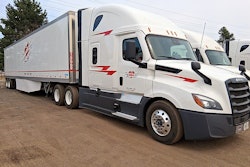Class 8 truck and tractor orders reached 24,300 units in October—an 18% monthly increase but a 22% year-over-year decline, extending annual declines to ten consecutive months, according to FTR Transportation Intelligence. Class 8 total orders now stand at 230,543 units over the last 12 months.
October orders fell short of the 10-year average of 31,198 units as FTR noted that fleets continued to defer replacement cycles and expansion plans due to several headwinds, including weakening freight demand, excess capacity, high interest rates, tariff volatility, tariff-related uncertainty, unclear regulatory direction, and narrowing profit margins.
While both the vocational and on-highway segments posted monthly improvements, the on-highway market saw the largest annual decline, which FTR noted indicates fleet reluctance heading into 2026.
Early signals for the 2026 ordering cycle confirm a cautious outlook, said Dan Moyer, senior analyst of commercial vehicles at FTR.
“Combined net orders for September and October are 32% below year-ago levels, highlighting persistent weakness in freight fundamentals and limited carrier profitability," he added.
October's sequential improvement likely reflects targeted selective replacement purchases rather than a return to growth investment, he pointed out.
For OEMs and suppliers, Moyer said order trends are expected to remain volatile until freight volumes and rates strengthen. For now, fleets are prioritizing “cost control and asset utilization over growth, delaying a meaningful rebound in equipment demand until economic and market conditions stabilize.”
Addressing new tariff measures on heavy-duty trucks taking effect this month, Moyer observed, “[It] will raise costs but is less severe and more targeted than expected. USMCA carve-outs, offsets, and the delayed parts tariff created a measured policy that encourages reshoring and strengthens North American supply chains.”
“Some production appears to be already shifting towards U.S. assembly, though expanding capacity will take time. Overall, the framework aims to boost U.S. manufacturing and reduce reliance on Asia while leaving room for future policy adjustments,” Moyer said.
Meanwhile, ACT Research reported similar figures, with N.A. Class 8 orders coming in at 24,500 units, down 21% annually.
Carter Vieth, research analyst at ACT Research, noted that this is a notably weak number when you consider October is seasonally the strongest month for orders with a 25% seasonal factor.
“This is the time of year when next year’s backlogs get built,” Vieth said, adding that elevated costs, soft spot rates, and continued uncertainty are constraining for-hire carriers and resulting in a subdued order season thus far.
Additionally, private fleet demand also cooled following recent fleet expansion, Vieth said.
On the medium-duty segment, Classes 5-7 orders fell 11% year over year to 15,500 units. Vieth noted economic uncertainty and “rising consumer pessimism” continue to suppress demand.














